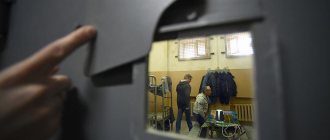Hierarchy of prison castes
In penitentiary institutions of the countries of the former USSR, there are 4 main categories (“suits”) of prisoners, as well as various intermediate groups. A characteristic feature of this hierarchy is the ease of transition from a higher caste to a lower one (this transition is called “lowering”, although this word is usually used in a narrower sense - transferring a prisoner to the “rooster” caste). At the same time, the transition in the opposite direction is usually very difficult or completely impossible. For example, to become a rooster, a prisoner only needs to sit in the dining room at the “rooster” table, while there is no way to move from a rooster to another caste.
Read also: Spelled porridge with milk
Blatnye
Blatnye are the highest caste in the hierarchy. These are usually professional criminals. Often it is the thieves who have the real power in a prison or zone. There are many requirements for applicants for the status of “blatny”: for example, a prisoner who served in the army, worked as a waiter, taxi driver and other servants (that is, the so-called “Chaldean”) could not become a criminal, although recently some of these requirements softened or were completely cancelled. Thieves, as a rule, do not work in the zone; where this is allowed, the criminal should not hold any official position (in this case he automatically becomes a “goat”). The thieves have the right to take from the “common fund” whatever they deem necessary, but at the same time they are obliged to take care of supplying the zone through illegal channels with food, tea, alcohol, etc., to resolve disputes that arise between prisoners from the point of view of unwritten criminal “laws” “(according to these laws, “correct” prisoners in the event of conflicts can only turn to thieves, and in no case to the administration of places of detention). At the same time, the criminal must act “according to concepts,” otherwise he may be omitted.
The thieves themselves, as a rule, do not call themselves thieves, but “prisoners,” “tramps,” “travelers,” etc.
"Guys"
Men are the largest group of prisoners. As a rule, they end up in prison more or less accidentally and expect to return to normal life after serving their sentence. They work, do not claim informal power and do not cooperate with the prison administration. At “showdowns” between thieves, men do not have the right to vote (although thieves can listen to the opinions of the most respected “men”).
Who are the divers in the zone?
What does a diver in the zone mean? A "diver" or "gasser" is the name given to a prisoner who clears the air in a cell after releasing gases from authorities or other prisoners. Usually physically weak prisoners who do not know how to stand up for themselves become “divers”.
Another reason for transferring to this caste may be a mistake in front of other prisoners. When someone in the cell wants to pass gas, the command is loudly given: “The guy wants to fart” or “The guy is ready to fart.” At this moment, the “diver” must run up to the speaker and press his face tightly to his buttocks, absorbing all the emitted gases into his mouth. After that, with his mouth closed, he runs to the window and lets them out.
If an unpleasant odor still appears in the chamber, then it is considered that the “diver” did not cope with his job. For this he can be beaten.
Read not only about how detainees live in prison, but also about the tattoos they give to detainees in prison.
Self-sufficient lepers
Psychologists who conducted studies of the behavior of prisoners belonging to various castes in a number of Russian prisons came to interesting conclusions regarding the self-positioning of representatives of the lowest of the prison categories of prisoners - “lowered” (“roosters”, “offended”, etc.). They, as a rule, do not want to leave their little world, fenced off from the bulk of prisoners - with personal places to sleep in prison cells or in detachments of colonies, dishes intended only for them and other “privileges.” Nobody touches them there, they are on their own. Moreover, the “omitted” to some extent feel their own need in the system of the prison world, realizing that there is no one else to do their dirty work (cleaning latrines, industrial premises, cleaning cesspools, etc.). Meanwhile, the isolation of the “lowered” from the rest of the prisoners is due not only and not so much to disdain towards them on the part of their cellmates, but rather to the fear of “being overworked”, “extinguished” by coming into contact with the “roosters”.
Tattoos of the Lowered
In most cases, such marks are derogatory in nature. They are applied to the buttocks, face, back or lower back. Moreover, if the rooster tries to remove the tattoo on his own, he will face severe punishment.
Let's look at the types of tattoos used for the lowered areas:
- Card suit or crown. The most common tattoos. Due to the use of such marks, roosters are often called “kings of all stripes.” The crown is most often five-pointed. There is a small white heart inside it.
- The inscription "daisy on the back."
- A five-pointed crown with a black heart indicates the willingness of the omitted to engage in all forms of sexual intercourse.
- Five-pointed crown with the signature "T.A.V.D.A." or with “Orpheus” instead of a white heart indicates the special status of “omitted”. Such tattoos are given to authorities in the circle of roosters. In prison they are called “chief roosters.”
- A dot or “sight” in the area of the eye or in the corner of the mouth.
- The image of a pig or a rat is stuffed with those who do not maintain personal hygiene.
- Tattoos of a naked woman entwined with a snake are applied to passive homosexuals. Most often the tattoo is located on the back.
Often the above designs are accompanied by short inscriptions that indicate the suit of the owner of the tattoo. Also, next to the tattoo there may be an article of the Criminal Code of the Russian Federation under which the citizen was convicted. Typically similar to rapists.
A tattoo is a kind of analogue of a passport in the zone. If a person understands prison symbols, then he will be able to form an opinion about a person, barely looking at his tattoo.
There are also several tattoos in the form of rings designed for lowered ones. Let's look at the most popular of them:
- A ring divided horizontally into two parts. Its upper part is painted black, the lower part is white. This type of tattoo was especially popular in the 90s of the last century. It was applied to card debtors. Moreover, in most cases, the tattoo was done by force. Upon release, the former prisoner painted over the white part of the tattoo, as a result of which its meaning changed to “time served.”
- A black ring with a diagonal white stripe and three black dots inside. This is the ring of a homosexual, which was stuffed with the offended and neglected in prison.
Have a question for a lawyer? Ask now, call and get a free consultation from leading lawyers in your city. We will answer your questions quickly and try to help with your specific case.
Telephone in Moscow and the Moscow region: +7
Phone in St. Petersburg and Leningrad region: +7
Free hotline throughout Russia: 8 (800) 301-39-20
Other types of omitted tattoos
The following tattoos are less popular:
- Roses and hearts (symbols of femininity). As a rule, they were stuffed onto the buttocks. Moreover, the heart means that the person has already been convicted of sodomy. The rosette indicates that the prisoner is “good in bed.”
- Eyes. Located in the lower back. Also on the buttocks there may be tattoos in the form of two bears that “play plates” when walking.
- Handshake with a flower sandwiched between hands. This tattoo indicates that the person is homosexual.
- Devil undressing a woman. In prison, the devil is a symbol of lust. Similar tattoos are placed on the backs of those who are depressed.
- Complex tattoos that include several elements. Often such marks are received by prisoners punished under article for rape. There may be four card aces, a girl, a devil, a signature of a humiliating nature.
- A girl catching a dress with a fishing rod. This tattoo is also given to rapists. It is located on the left forearm.
- Boar in profile indicating the article of the Criminal Code. Usually this is part 3 of article 131 of the Criminal Code of the Russian Federation. This tattoo is tattooed on the back of pedophile rapists.
- On the buttocks of people convicted of sodomy, there was a tattoo in the form of a dark male fireman.
- Ace, little imp, bee on buttocks. The custom of punching the offender with an ace after each sexual intercourse is present in some prisons. Moreover, some passive homosexuals have many such small tattoos. Sometimes free space simply runs out.
- Why is it easier for them to live there?
- Well, it’s like you just don’t have to follow anything anymore. You won't go anywhere lower. That is, you just gave up on yourself and went there, you already live, you exist. — When they decide whether to send them to a “harem” or not, is it some kind of court meeting or what even happens? - Well, the decision is still made by the people who have a say in the camp. It’s not always, say, the “looker.” That is, these are just men who have gathered, who are covered by all the actions of this person, and so they make such a decision. But again, there must be a specific person who is responsible for order in the camp, for, say, understanding of the convicts. The “observer”, or the “thief”, or some kind of “statist” - these people must make the final decision. And again, this should remain directly on their conscience. They will make it right or wrong. - If, for example, they made their verdict, but the person does not agree? - In any case, the person does not agree. But here, let’s say, you can’t argue with the laws. That is, here, as it is, so it is. In any case, you can somehow justify yourself. But, as a rule, there is no turning back. There is always a choice. First of all, you can kind of stop it right away. That is, you understand that this will happen and you have to do something. Someone is opening a vein. Someone is breaking through the “hut”. You have some choice. A rare case happens when this all suddenly happened, due to some circumstances. You couldn't do anything. Take a knife and cut those who did this. - If you kill your offenders, will that somehow justify you? “You won’t be able to leave the harem, but at least I won’t pester you anymore.”
Lowering
A characteristic tattoo of the “lowered one” - a dot above the upper lip
The decision to (transfer to) is made at the “bazaar” (gathering of authoritative prisoners); in some cases, they are transferred to roosters “without a bazaar” (that is, based on the very identification of the relevant fact: child rapists, homosexuals, former police officers). Lowered (), often with the entire camera. Before rape, the person being lowered to suppress resistance is often beaten or strangled with a towel until he is semi-conscious; sometimes, in order to avoid being bitten during oral sex, the front teeth are knocked out (for example, using dominoes). However, in order to be transferred to the lower class, rape is not necessary; in many cases, a prisoner is simply swiped across the lips, (urinated on or on the face), poured with water from a bucket, passed over the lips with a slipper, etc. Sometimes a ruling from the “authorities” is sufficient - consider such and such a prisoner a “rooster”. After this, the prisoner is considered released. A person who has been dejected is sometimes forcibly given a tattoo - a sign of belonging to a caste (an image of a rooster or a devil, on a dot above the upper lip, the word, a patterned ring around a finger (for a person who has made such a tattoo in his freedom out of ignorance, in case of being imprisoned or meeting with "thieves" this can lead to serious consequences), etc. Sometimes a prisoner who has committed a serious offense can himself go to the omitted, without waiting for the inevitable punishment (for example, by moving things to the rooster corner of the cell). In this case, no additional procedures are not carried out. In the last two decades, “lowering” has practically not been used in prisons and colonies. Because it is from those forcibly “lowered” that the administration in “red” institutions forms so-called active accomplices of the administration, who are sent to solve operational problems. Often these "accomplices" carry out reprisals against the authorities. According to current concepts, forced "lowering" is "whoredom", that is, an act that is punishable up to death.









